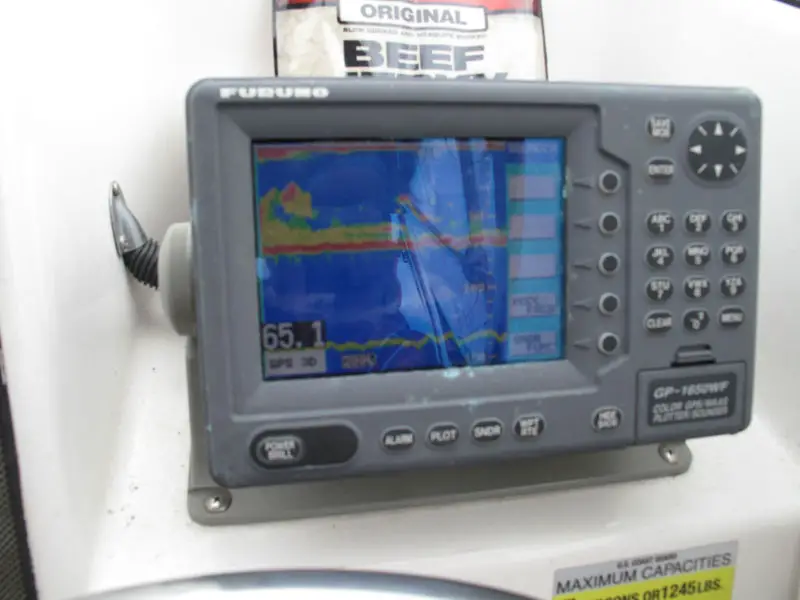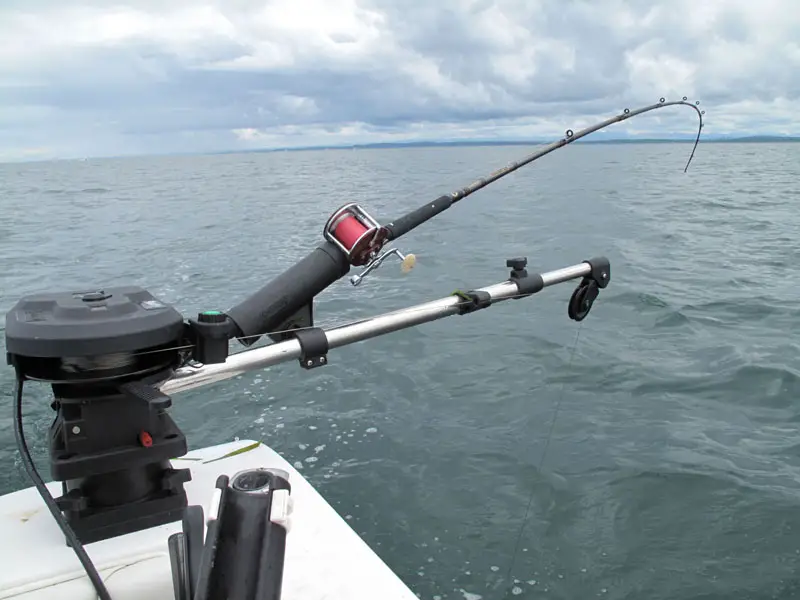Search
Latest Articles
Westport Chinook
by Jason Brooks, July 07, 2012
The bar crossing wasn’t bad on this day as we chased after the charter boats. Figuring they knew where the fish were we stayed the course beside them and soon found ourselves just off shore from the towering beachfront hotels of Ocean Shores. These are probably the two most important things to learn on how to fish out of Westport. The first being the bar into the Pacific Ocean from Grays Harbor which can be calm and easy or rough and deadly. Be prepared for the worst conditions and check in with U.S. Coast Guard. Luckily the public launch out of Westport is located right at the Coast Guard station. Flag warnings are flown from the station and weather reports can be found by checking with NOAA.
The charter fleet out of Westport is one of the main economic engines that drive’s this small town. Along with commercial fishing and cranberry bogs there isn’t much else other than the occasional surfer that takes advantage of the high surf just south of the jetty near town. So, the second thing to remember, after checking on the bar conditions, is to watch the fleet of charters. Their main goal is to get their clients onto fish and do it as quickly as possible since fuel for the ships is expensive. On this day we simply followed the fleet north and once we located several charters who floated along mooching for salmon we started our troll.
Grant dropped the first line down as I tied up another dodger and squid combo and before I could clip it into the downrigger the first rod jumped. Grant grabbed it but the fish was gone. Soon enough we had two rods working the downriggers and I let out a top water rod tipped with a 2 ounce banana weight with a Brad’s Killer Cut Plug 36” below it stuffed with some minced herring. A half hour later the second fish was on and I handed Alan the rod. Boating the first king of the day Alan took the helm while Grant and I worked the downriggers.
Once again I noticed the rod popping off of the downrigger and grabbed it from the holder. Ocean Kings provide a great fight and with the barbless hooks it causes a near heart attack knowing the fight could end at any second. I boated the second King of the day, a nice 14 pound fish.
Keeping an eye on the sonar and chasing around bait balls we were able to stay with the Kings. This is truly the key to catching kings in the ocean or even in Puget Sound. Since the fish are opportunity eaters and are always feeding to put on weight before the fall urge to head for freshwater takes over, if you find the bait you will find the salmon. An old fisherman’s trick is to watch for sea birds. As herring are chased from underneath they form a tight ball to try and distract the predators. But once in the tight ball of herring if salmon continue to prey upon them they are pushed up to the surface. This is because salmon can only look upwards and forwards so they attack the herring from underneath. You know you have found a good bait source with feeding salmon underneath when the surface of the ocean starts popping with herring. I spotted a group of pelicans working the surface and told Alan to motor that way. It was only a matter of seconds before the line popped off the downrigger with another fish.
Grant finally hooked up and when the fish came to the boat he decided the small 6 to 7 pound fish wasn’t worth punching out on so he pulled the hook out and it swam free. Alan and I started giving Grant a bad time about “one with the hand is worth”, well in this case, “two in the salt” but Grant said he would get the last laugh and sure enough a half hour later he fought his King to the boat. Luckily it was an inch shorter than mine so he couldn’t rib me too hard.
With our king limit in the icebox we tried to find the Coho. Raising the downriggers up 20 feet from the 60 foot depth should have done the trick. About every half hour it was “Fish on” and each time a nice mid-teens King came to the edge of the boat. Finally I grabbed the rod as is danced free of the downrigger and the fish immediately hit the top water. I struck silver! But as we started to slide the net under the fish I noticed an extra fin. Keeping it in the water I reached down and pulled the hooks out and told Grant to drop the net. Our only Coho of the day swam back to find more herring.
A few minutes later the surface rod exploded and I grabbed it just knowing this top water presentation should lead to a Coho, but nope, another mid-teens King came to the boat. We were laughing at how we were hoping we wouldn’t catch Kings anymore and just wanted Coho. You know you’re spoiled when you say “It’s just another King”.
After 6 hours of fishing with 7 Kings and 1 Coho to the boat we headed for port. The bar had calmed down even more than our morning crossing and it was a pleasant ride in. Once back at the dock we were met with Gray’s Harbors Finest and a WDFW Officer, along with a fish checker.
A quick boat inspection and a wave of the magic fish wand revealing no nose tags and off to the gas station for some ice and the end to another great trip. The Kings are in at Westport.
Gear: The most important thing for this fishery is a boat that can handle the open ocean and the crossing of the bar. After that it’s a matter of taste or what you have when it comes to how to fish for kings and Coho in the big blue. Starting with our setups on this day, we were using 8 ½ foot downrigger rods with 50# braid. I would recommend either 65# or #80 braid instead as we had a lot of false releases with the thin diameter #50 braid. I tied a stainless steel #80 barrel swivel with a McMahon clip which allows for a quick change of presentations. From there I clipped on an 11” green “Hot Spot” dodger with 28” of 30# mono leader to a double hook set up threaded through a squid bait, also known as “hoochies”. The favorites on this day were the Ace Hi-Fly in orange and a UV Purple Haze from Gold Star. I also like Sledge Hammers from Macks Lure. Make sure you have various color combinations as daylight conditions can change up what the fish like. Most of the time there will be a marine layer causing it to be filtered sunlight which is where the UV treated lures really make a difference as the UV light is the brightest on these days. Then put a fillet of a herring on the top hook for scent and drop it down to the desired depth with your downrigger.
If you don’t run downriggers there are still several other options. In fact if targeting Coho or if a spare rod can be run out of the boat like we had on this day then a “top water” rod, as I like to call it, should be used. Since this is a third rod for us (there were three of us fishing on the boat and we are each allowed a rod) I am a firm believer in the K.I.S.S. method (Keep It Simple Stupid). I don’t like to stack downriggers as this can cause a mess. So I employ a rod that trolls along in the top 20 feet and with a presentation that I know is always working. I clip on a 2 ounce banana weight into the McMahon snap and from the weight I tie on a 36” single hook leader threaded through a Brad’s Killer Cut Plug. I mince up some herring and put it into the cavity of the plug. This way I know if a fish strikes at it but misses that the plug will keep working. You can use a cut plug herring but those missed strikes means you need to reel in and re-bait.
Another “secret” of mine is that I actually tie a 6 bead chain swivel on the end of the leader with a split ring on the end. I then attach the hook to the split ring (make sure you pinch the barb as all salt fishing in Washington requires barbless hooks). This does a couple of things. The most important is that it sets the hook a bit further back from the end of the plug. Most salmon miss the plug by coming up short and this makes up for that. Another thing it does is help the hook stay in the fish. As the fish twist and turns in the fight the hook spins freely and doesn’t cause a gap where it penetrated into the fish’s jaw which makes it harder for the fish to throw the hook. I troll this set up about 40 feet behind the boat.
Other options for downrigger free fishing are to mooch just like the charter boats or to use a bait diver of sorts. When I mooch I try and stay right on the herring balls. You can do this by keeping a close eye on the sonar and using your motor to go where you need to. If you want to relax a bit more you can cut the motor and just bob along while talking with friends and mooch, but you should still glance at the sonar once in a while. By knowing the depth of the bottom of the bait you know how far down to drop your offering. Once in the zone you can either mooch up and down or once in a while it’s a good idea to reel up a crank or two after you drop your rod tip back down. This works the water from the bottom of the bait to the top and at any time a Chinook could grab it.
For those that want to troll deep without downriggers you can use a multitude of divers. I like the “Deep Six” and “Double Deep Six” that have a clamp which pops free when a fish strikes and become an in-line weight. To use a diver of sort effectively though you need to use a pretty stout rod and I have a 10 foot extra heavy Ugly Stick just for this purpose. It gets the offering out away from the boat and motor and is strong enough to keep the diver pushing down without causing the rod to fail, and since it’s an Ugly Stick I can put as much force on it as I want without worry of it breaking. Due to the heavy weight and diving force of the diver I don’t use dodgers but instead use in-line flashers like a “Big Al’s Fish Flash”. I also like to use Coyote spoons of various colors for use with the in-line flasher as the squid bait really needs the action from a dodger to be effective.
Other essentials: remember your out in the open ocean. Take along all of the required safety gear, including life jackets (which I always wear on the open ocean), flares, horn, throwing life ring, rope and of course most of all, know how to use it. A VHF radio, GPS or better yet GPS plotter and sonar are pretty much essential as well. Turn your GPS on before leaving the dock and if it has a breadcrumb feature make sure it’s working too. At least this way if bad weather or fog rolls in you can follow your path out back in to port.
One last note and that is when to go. This is pretty much not up to us as fishermen. The best time to fish for Westport Kings is when we can. With seasons at the discretion of the WDFW be flexible enough to throw together a last minute trip like the one I described above. By being flexible you will be able to go when the season is open, the weather conditions right, and the motels with vacancy. Well you can always sleep in the boat or in the back of the truck so I guess really a bed is a luxury. Either way the trip to Westport is well worth it for an open ocean Chinook.
Jason Brooks, July 2012








